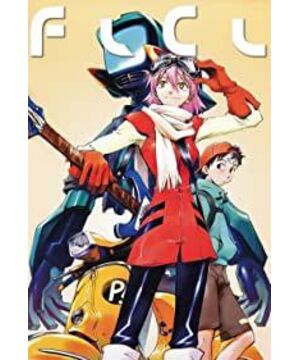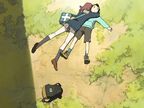To be honest, I don't really like to write reviews, because the process is usually long and not fun, and I don't always like what I write at the end unless something is really important to me. Such as "EVA", such as "FLCL".
So, a little bit about my understanding of the work "FLCL".
As an experimental animation, FLCL may not have put much effort into the plot at first. Whether it is setting, painting, or the abstract expression technique, there is a feeling of how it came about at will. This has also led to a lot of content in this animation being expressed in an "inexplicable" way, and the audience who watched it earnestly would naturally feel inexplicable. For example, the inexplicable rock music at the beginning of the cartoon, the inexplicable heroine drives a Vespa motorcycle and bumps into the hero inexplicably, and inexplicably picks up the bass in her hand and smashes it at the head of the hero. The inexplicable complaints are accompanied by inexplicable dialogues. Start to expand.
Considering that this film review is still instructive, here is a brief explanation of what kind of settings these inexplicable developments originated from.
In the detailed setting of FLCL, when the minds of adolescent boys and girls begin to throb, the mind will produce something called NO. According to the setting, this thing can open the super-space tunnel and send all substances over. or absorb it. (Tucao: Brain hole?) The reason why the heroine drives the Vespa to the hero is to pick up the bass in her hand and hit the hero's head. In doing so, she can use her ability to open the hero's NO, so as to get She wants what she wants, and she drives her special Vespa all over the universe for what she wants.
This setting sounds pretty crude and almost illogical, but even so it's important to understand the actions of the characters in the story. However, this setting is only made clear in the penultimate episode of the story.
In fact, judging from the action of the production team, they don't seem to care whether you can understand it or not, they just did it. Therefore, most people's first experience of watching FLCL must be carried out in a confused way, including me. I have to say, though, that this bewildering process was still quite interesting.
I have always believed that the production of an animation, whether it is bad or good, is the most important thing for the audience. This experience can come from two aspects, one is the plot performance, and the other is the essence of animation - "sound and picture performance". According to popular taste, the former is more important. Therefore, we can see that paintings such as "Hakata Tonkotsu Ramen" and "Backstreet Girls" are not very good or even bad works can still be well received by the audience and become popular. The former is because the story is good enough, the latter although There are too many gimmicks, but they still play the essence of funny animations well. In short, they all bypass the essence of animation, and then attract the audience through the story itself. This is a common practice and the most effective way. And FLCL is another way, it ditches "storytelling" in the beginning, doesn't tell you too much, leaves the audience confused, then bombards the audience's brain with textbook-level painting, and indirectly makes You feel the story. This approach may not be very clever, and it is not universal, but it does work, provided your "picture" can have enough impact, like FLCL.
So, although we don't understand why a humanoid robot drilled out of the hero's forehead and fought with another hand-shaped machine drilled out, the production team is still working hard to focus on the tip of the knife. From the first episode, the master painting master Ji Chengyao told us what the top painting level in 2000 was like with a hearty fight scene, and combined with the last paragraphs of quite intense punk music, even if you really watch I don't understand, but you can fully appreciate this sound and picture performance that is not far behind today. For a painting lover like me who likes punk, it is a complete spiritual enjoyment. And this kind of plot runs through almost the entire FLCL.
That's one of the charms of the FLCL, years from now you may not remember what the story is about, but you may remember the pink-haired girl knocking an electric guitar out of the boy's head with the bass, and then Fly into the sky on a motorcycle and fight those strangely shaped things that come out of their foreheads. You will think of these powerful images, and then keep these images in your heart like the slogan "Charge for 5 minutes, talk for 2 hours", which will be unforgettable in your life. This is where it succeeds.
Although I wrote a lot of nonsense to express a point of view: the brilliance of FLCL is not in its brilliant plot, but in the experience it brings to the audience with its wonderful paintings and musical performances, but the plot is still a part that cannot be ignored for FLCL.
Yes, this story is not that exciting, and even the expressions in many places are exaggerated and lack basic logic. Throughout the whole FLCL, the best plot performance should be the third episode. In this episode, the shaping of the characters, the interestingness and completeness of the story are quite good, giving a full impression. But the overall performance is not good, as I mentioned above, due to the lack of performance of the basic setting of the story, many times it is still confusing.
I have previously commented that "Shape of Sound" is not a good work. Its problems include but are not limited to the general character setting and character image, and the lack of focus on the plot. But no matter how you look at it, it's hard to make you think this is a bad work. I think one of the big reasons is that the atmosphere of the story it creates is very good; youth, friendship, family affection, love, these elements Make the story warm and you'll feel like it's not done well enough, but it's hard to say directly, it sucks.
The same is true for FLCL, the story atmosphere it creates is also great, and here is a theme of FLCL: youth.
The word runs through the story just as well as FLCL's wonderful painting, making what was supposed to be a terrible story experience alive, funny, and real.
In the first episode, the male protagonist Naota told Mami that his brother had a girlfriend overseas, and he felt dizzy when he saw Mami. He wanted to protect Mami, but because of this idea, he opened the NO on his forehead and turned the robot sent over. Simply analyzing this part, the reason why Naota turned on NO was because she fainted when she saw that Mami was hurt by the "truth", which resulted in the desire to protect this big sister who had a good relationship with herself. According to the setting, NO will be opened because of the mood swings of adolescents, so the rationality of the plot development is reflected here.
Aside from "robot" and "NO", which are displayed in the need of the plot, this plot is actually showing the thoughts of adolescents: girls with good relationships have been hurt both physically and mentally because of something, and they are in a friendly relationship. The justice or the justice of male hormones will naturally generate the idea of wanting to "protect" the other side. This is something that does exist in reality, and FLCL just uses an exaggerated way to embody it.
There are many such plots, such as Naota who deliberately drinks bitter coffee because she wants to pretend to be mature, Mami who treats Naota as a spiritual substitute because her sweetheart left, or at the end of the story, she mustered up the courage to let go. All the Zhitai who expressed their hearts, these plots are showing youth and the growth on the road of youth through some exaggerated and impactful pictures, and finally let you feel a familiar atmosphere, those hidden in your old school bag. The nostalgic atmosphere in the album, or recorded in the album.
I don't think this kind of atmosphere will change the emptiness and pompousness of FLCL's overall plot, but it at least gives us the wrong idea that the story is, in fact, not bad. Because of those thoughts, those strange emotions, we may have experienced more or less.
Originally, there is no need to go too deep into the plot of FLCL, but here are a few more words about its role modeling.
The core of FLCL is youth and growth in the final analysis, so the characters in it should be boys and girls in adolescence. For example, Naota, the hero who pretends to be mature but still a child at heart, Mami who keeps looking for a substitute to fill the void in her heart after a breakup, Eri, the monitor who is calm and composed in a family crisis, and the soul character of FLCL who is lively and energetic But at heart is the sophisticated and cunning heroine Haruko. Excluding the heroine, the above characters are all in the process of adolescence and represent different adolescents. As the story progresses, each of them is growing, and finally enters the next stage of youth. The male protagonist has been growing up on the way of pretending to be mature, from the time he doesn't drink too sour drinks to the one who tries to drink bitter coffee; he never dares to face his feelings for Haruko, and then he is willing to say "I like you" to Haruko. , These are all manifestations of the male protagonist's growth process.
As for Mami's growth, it will come later. After losing her senior, she has always been in a state of self-isolation, and she has not tried to get out of this situation, but has been replacing the available substitute "Atai". I hope that the "A Tai" in her heart can always be within her familiarity, so that "A Tai" will never abandon her. So, when Naota swung the electric guitar in her hand to blow up the baseball bomb that would destroy the town, Naota was no longer the "Ata" in her heart, and she had to look for a new replacement. After all, she has taken a lot of detours. But at the end, she also witnessed Naota's growth with her own eyes, and then recorded it all, said goodbye to Naota and her past, and went on a new journey in life. I think at the end of the story, this character also got Growing up, she no longer looks for any replacements, but simply ends everything and accepts a new self, which may be what we have experienced growing up in reality.
Welly's image is my favorite. When the family crisis appeared, she showed a rare calmness and composure at this age, and she tried to accept or endure it silently. She endured as the mayor's father and female secretary. The extramarital affair, and then calmly waited for the parents' choice. I like this character very much, because she shows the "maturity" as a child, the kind of real "maturity" who doesn't cry or make trouble when encountering things, and occasionally plays a little clever Gradually growing up, she let go of the obstacles in her heart, and then frankly cried to her parents. Although the story did not tell us whether the family crisis of Hui Li was resolved at the end, we can feel the transformation of this character from the fragments of these plots. , Perhaps, she is the first child in the story to become an "adult".
As for the heroine Haruko, there is not much to talk about. In my personal understanding, this character more represents us after the end of youth. In the story, Haruko drives her magical Vespa around the universe in pursuit of the power of "Pirate King" Atomusk, and will do anything for it, even using everything around her. It might be a bit disappointing to say that, but it seems to me that all of Haruko's actions and emotions towards Naota are just to use him to gain Atomusk's power. From episode 4, when Haruko watched the baseball bomb coming to the town, and she didn't have any expectations for Naota, she could feel it. In her eyes, Naota's feelings, the safety of the people in the town, everything on this planet is related to She doesn't care, she just wants what she wants. So at the end of the story, she watched Atomusk run away again, and rode the Vespa without any hesitation, then pretended to ask straight "Would you like to come with me?", and immediately said, "No, you're just a child. "In Haruko's eyes, Naota is just an immature child, even though he has grown up, the feeling in his heart is still immature, and in her eyes it's not worth mentioning, so she left Naota and left. This is undoubtedly the indifferent rational thinking of adults. It's better to leave what is useless to oneself, and there is no need to keep it as a souvenir. This reminds me of the line: "Children can distinguish right from wrong, adults only see the pros and cons." In my opinion, youth and growth are nothing to Haruko. She has long since left this stage. From the beginning to the end of the story, she has always been the most mature one.
Looking back, I want to think again, what is so good about FLCL? So much so that I have watched it more than 3 times in its entirety, trying to penetrate those details and emotions like it was drained of blood.
Excellent sound and picture performance? This may be a very crucial factor. The dream combination of Yoshiyuki Sadamoto and Kazuya Tsurumaki makes me, an EVA fan, absolutely unable to refuse its paintings, not to mention the master painters such as Imaishi Yoyuki and Ji Chengyao; the classics of the pillows Japanese punk was ringing from start to finish, and I, who listened to ELLEGARDEN through my teenage years, couldn't stop getting excited from those slaps. And those two combine to make a FLCL show that's as addictive as LSD to me and totally immersed in it.
Those stories that symbolize youth? Maybe it's not that important to me, there are many stories of youth, FLCL may not be the most outstanding one, not to mention its plot is really hard to describe...
Writing here, I suddenly thought of the unofficial translation of FLCL - "Special Her". This translation may have a wider spread than FLCL's real name, but due to the small entertainment of this work, there are not many people. will bring it up. However, according to the story, Mami, Eri, and Haruko, these three female characters may be regarded as "special her" in adolescence to the male protagonist Naota.
What is the original meaning of FLCL? From the pronunciation, it is the sound of the chest rubbing in Japanese, which symbolizes the sexual fantasy of adolescence; from the meaning that the director Tsurumaki Kazuya wants to convey, it means Fooly Cooly, stupid and cool. , is also a metaphor for everything about youth; in the explanations given by some fans, it means First Love Cyber Love... In short, it has many explanations, and these explanations are as confusing as the story of FLCL itself.
I thought and thought, watched a few more episodes of FLCL on and off, and wrote my answer.
FLCL excels because it doesn't try to make us understand stories, it encourages us to feel them.
I have thought about the difference between FLCL and other fantasy animations. Many fantasy animations will tell you the settings clearly. If you can't tell you, tell you through stories, and then expand the plot on this layer of settings. After understanding them and getting your own feelings, and these feelings come from the setting of the story, the arrangement of the plot, the actions of the characters, and finally when you see the ending, you also understand how the story happened and how it was carried out. how it ends.
The FLCL discards the process of "understanding," or rather, it makes it less of a primary viewing purpose. So the production team didn't tell you NO at the beginning, nor did they tell you how robots and monsters drilled out of the boy's forehead. These may be important, or they may not be important at all, because you don't need to understand FLCL, it's like, If the word Fooly Cooly didn't appear at the end of the story, you probably wouldn't have understood that FLCL had this meaning from beginning to end.
FLCL has made some people, including me, rethink the meaning of the story. If we watch the story, we have to understand the story. Are we caught in the struggle of thinking in the process of watching? I watch FLCL, look for logic and rationality in those powerful pictures, and try to understand it, is this a contradiction, or a mockery?
I don't think that's what the director intended. The point of FLCL is that it doesn't need to be understood, you just need to feel it. In the FLCL, we will see a plot where the male protagonist faces a huge baseball bomb flying towards the town and summons the courage to hit it back with an electric guitar. This plot lacks rationality and logic and is difficult to be read Understand, but the fact is that it doesn't need to be understood, you just have to see the hero finally swing his "bat" after he mustering up his courage, and see him pick up the sour soda he didn't like and drink it , you will feel his growth and the throbbing of youth. That's what the FLCL brings to us.
Before FLCL was released, we had EVA, Akira, and many obscure stories, some of which may have many different interpretations, but there is no standard answer. But maybe we never need a standard answer, all we need is to feel the story, try to understand it, and get our own answer, and that's enough. Maybe many of us watch the story with the intention of understanding it at first, then get a string of question marks, then give up after being overwhelmed by these accumulated question marks, and then turn to experience how the story makes us feel, those who hide In the lines, in the picture, the breath of youth.
Then you will find that you suddenly understand the metaphors that appear from time to time in the story, the exaggerated images that appear from time to time, and the symbols behind it, and finally remember the string of English that appeared on Mami's cigarette in the first episode of the story— — "Never Knows Best".
Maybe not knowing is best. That's the invaluable thing I learned from FLCL.
In the end, I want to try to interpret the string of "Never Knows Best" in the first episode of the story.
After checking, most of the understanding on the Internet is the original meaning of this sentence - "never know the best", this is youth, I have been confused, and I have never understood what is the best.
My understanding of this may deviate from the original meaning of English. My understanding is - "Never know is the best."
Never knows anything. That's best.
This coincides with the story of FLCL. You don't have to know what it is about, and you don't have to understand it. After you read it, it's over. It doesn't need to be interpreted by you. You better never know about it. , it's not clear, which is the best for you.
Yes, those strange settings, those vigorous fights and explosions, those mysterious characters and organizations, you don't need to understand them, you only need to feel the inexplicable stories and the music of the protagonists, and what these things bring to you A sense of youth is good.
Because youth is inexplicable.
View more about FLCL reviews










